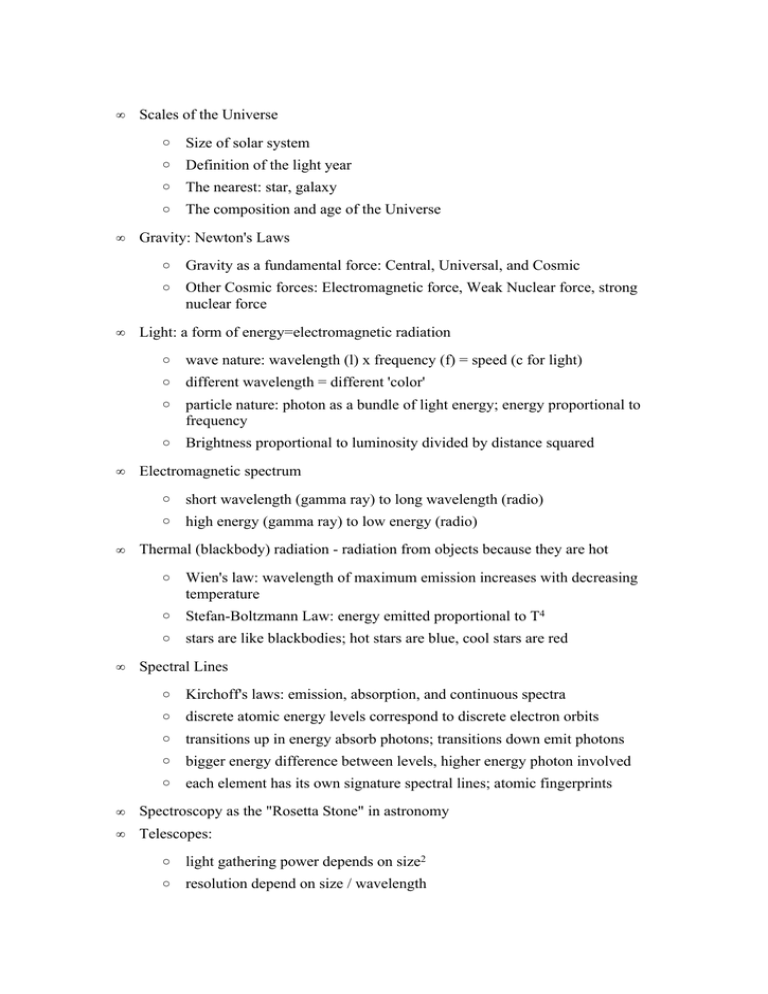Scales of the Universe Size of solar system The nearest: star, galaxy
advertisement

• • • • • • Scales of the Universe o Size of solar system o Definition of the light year o The nearest: star, galaxy o The composition and age of the Universe Gravity: Newton's Laws o Gravity as a fundamental force: Central, Universal, and Cosmic o Other Cosmic forces: Electromagnetic force, Weak Nuclear force, strong nuclear force Light: a form of energy=electromagnetic radiation o wave nature: wavelength (l) x frequency (f) = speed (c for light) o different wavelength = different 'color' o particle nature: photon as a bundle of light energy; energy proportional to frequency o Brightness proportional to luminosity divided by distance squared Electromagnetic spectrum o short wavelength (gamma ray) to long wavelength (radio) o high energy (gamma ray) to low energy (radio) Thermal (blackbody) radiation - radiation from objects because they are hot o Wien's law: wavelength of maximum emission increases with decreasing temperature o Stefan-Boltzmann Law: energy emitted proportional to T4 o stars are like blackbodies; hot stars are blue, cool stars are red Spectral Lines o Kirchoff's laws: emission, absorption, and continuous spectra o discrete atomic energy levels correspond to discrete electron orbits o transitions up in energy absorb photons; transitions down emit photons o bigger energy difference between levels, higher energy photon involved o each element has its own signature spectral lines; atomic fingerprints • Spectroscopy as the "Rosetta Stone" in astronomy • Telescopes: o light gathering power depends on size2 o resolution depend on size / wavelength o mechanical and optical specifications o instrumentation: photometry, spectroscopy, imaging o advantages and disadvantages of astronomy from space o adaptive optics o Atmospheric transmission : optical, radio transparent, infrared : partially opaque, UV opaque, X-ray through γ-ray opaque • • • • • The Sun o surface features: sunspots, prominences, corona, etc. o energy transport by radiation, conduction and convection o energy production by nuclear fusion: E=mc2; 4 hydrogen -> 1 helium + energy o solar neutrino problem Stars o stellar spectra: hot to cool (=blue to red): O,B,A,F,G,K,M o distances via trigonometric parallax o radial velocity: the Doppler effect o change in wavelength (Δ λ) divided by wavelength (λ) = velocity in line-ofsight / c o ranges of luminosity and temperature The HR Diagram o 2-D classification scheme: luminosity versus temperature (or color) o main sequence, red giants, white dwarfs o stellar mass via binary stars o the main sequence: higher mass = more luminous = bluer = rarer o main sequence life time = 10 billion years divided by mass3 Star Clusters: key objects for stellar evolution o associations, open clusters, globular clusters o stars become red giants when hydrogen exhausted in core o main sequence peeled down with age o oldest clusters are 12-14 billion years old Stellar evolution o star formation in molecular clouds; triggers, protostellar collapse, nuclear ignition o main sequence - longest stage o core H exhaustion - become red giants o helium ignition - helium flash if mass less than twice sun o core helium exhaustion: giant branch again o M < 8 solar - white dwarf exposure and planetary nebula formation o M > 8 solar - burns carbon, oxygen, ... to iron o no energy from iron burning - collapse - supernova All matter heavier than carbon has been formed in the core of a star that exploded as a supernova • • Stellar end states: o white dwarfs: size of earth, mass of sun, density up to 1 million times that of water o supported by degenerate electrons, maximum mass = 1.4 solar o neutron stars: detected as pulsars, mass of 1.4 solar but size of Ames, neutron degeneracy o black holes: so dense that escape velocity greater than speed of light o detecting black holes - massive binaries and X-ray emission o gamma-ray bursts as sites of black hole production via hypernovae The Milky Way o the interstellar medium o basic dimensions and structure: ping-pong ball in CD, 100,000 light years across o rotation: fast rotation in outer parts indicates there must be a dark massive halo o spiral arms - spiral density wave • The Milky Way neighborhood - nearby galaxies like Andromeda, Magellan clouds • Galaxy Types: spirals; barred spirals: ellipticals • Galaxy Distances - the distance pyramid; more reliable close by, less reliable farther away • o Cepheid variable stars: period-luminosity relation o internal velocity dispersion correlation to luminosity (Tully-Fisher) o Type Ia Supernovae, average galaxy characteristics The Hubble Law o velocity of recession (through Doppler) proportional to distance o the Hubble constant: H, in range from 50 to 100 km/s per million parsecs best current value is 74 o the expanding universe: all galaxies move away from each other o no center for expansion, not an explosion • • • Freaky Galaxies o Quasars - point-like objects with huge red Doppler shifts - large distances o rapidly varying brightness - small o high luminosity o huge structures visible at radio wavelengths o Active galaxies (Seyferts, BL Lac objects, radio galaxies) o supermassive black hole as energy source Clusters and superclusters o galaxies cluster on the megaparsec scale o clusters also show larger scale organization: the great wall Cosmology - a big, expanding, and structured universe o age = 10 to 20 billion years (best guess: 13 billion) o expansion now implies a Big Bang in past o Big Bang - produced H, He, and lithium from initial pure energy fireball o tests - pervasive 3 K background radiation - observed by COBE o seeds of galaxy formation discovered by COBE o Open vs. Closed universe: the critical density; tests; current guess is open o inflation - rapid early expansion leaving us with density equal to critical density o the accelerating universe - Type Ia supernova results o Imaging the first galaxies: the Hubble Deep Field and Ultra Deep Field o if closed, recycled universe (bang, expand, contract, crunch, bang, expand, ...





